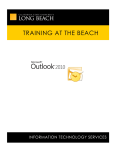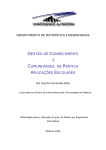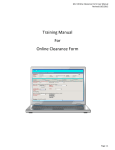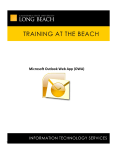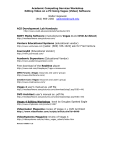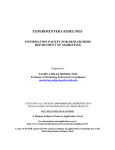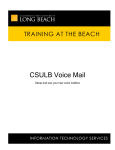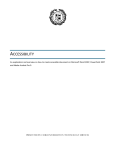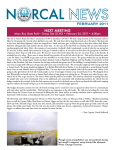Download Outlook 2011 User Manual
Transcript
Contents Contents ........................................................................................................................................................ 3 Section 1: Getting Started ............................................................................................................................. 6 Outlook Applications ................................................................................................................................. 6 Opening Outlook ....................................................................................................................................... 7 The Interface ............................................................................................................................................. 8 Outlook Menu ........................................................................................................................................... 9 Section 2: Mail ............................................................................................................................................ 10 The Home Tab ......................................................................................................................................... 10 New Commands................................................................................................................................... 10 Delete Commands ............................................................................................................................... 10 Respond Commands ............................................................................................................................ 11 Move Commands ................................................................................................................................. 12 Setting Email Preferences ....................................................................................................................... 12 Email Signature .................................................................................................................................... 12 Rules .................................................................................................................................................... 15 Out of Office Greeting ......................................................................................................................... 18 The Folder Tab ......................................................................................................................................... 20 Creating Folders ................................................................................................................................... 20 Renaming Folders ................................................................................................................................ 21 Moving Folders .................................................................................................................................... 21 Deleting Folders ................................................................................................................................... 22 Moving Messages to Folders ............................................................................................................... 22 Searching Mail ......................................................................................................................................... 22 Using the Search Box ........................................................................................................................... 22 Filtering Email ...................................................................................................................................... 23 Junk Mail.................................................................................................................................................. 23 Receiving Junk Mail.............................................................................................................................. 23 Junk E-mail Options ............................................................................................................................. 25 Section 3: Contacts ..................................................................................................................................... 27 Opening the Contacts Folder................................................................................................................... 27 CSULB 3 Information Technology Services The Home Tab ......................................................................................................................................... 29 Creating a New Contact ....................................................................................................................... 30 Editing Contacts ................................................................................................................................... 31 Creating Contact Groups ..................................................................................................................... 31 Searching for Contacts ......................................................................................................................... 31 Section 4: Calendar ..................................................................................................................................... 32 Using the Calendar Navigation Pane ....................................................................................................... 33 Customizing Calendar Views ................................................................................................................... 33 Creating and Editing Appointments ........................................................................................................ 34 Understanding the Appointment Tab ..................................................................................................... 36 Using the My Day Feature ....................................................................................................................... 37 Scheduling Meetings with Exchange Server............................................................................................ 38 Scheduling a Meeting .......................................................................................................................... 38 Responding to a Meeting Request ...................................................................................................... 41 Tracking Responses.............................................................................................................................. 42 Adding and Removing Attendees ........................................................................................................ 44 Cancelling a Meeting ........................................................................................................................... 45 Section 5: Tasks ........................................................................................................................................... 46 Understanding the Home Tab ................................................................................................................. 46 Creating a New Task ................................................................................................................................ 47 Editing a Task ........................................................................................................................................... 48 Customizing Tasks Views ......................................................................................................................... 50 Section 6: Notes .......................................................................................................................................... 52 Section 7: Office Web App (OWA) .............................................................................................................. 54 Logging In ................................................................................................................................................ 54 The OWA Interface .................................................................................................................................. 55 Feature Differences ................................................................................................................................. 55 Email ........................................................................................................................................................ 57 Creating New Email ............................................................................................................................. 57 Responding from within the Reading Pane ......................................................................................... 58 Responding from within the email ...................................................................................................... 58 Deleting Mail........................................................................................................................................ 58 CSULB 4 Information Technology Services Organizing Mail ....................................................................................................................................... 59 Creating New Folders .......................................................................................................................... 59 Renaming and Deleting Folders ........................................................................................................... 60 Contacts ................................................................................................................................................... 60 Personal Contacts ................................................................................................................................ 60 CSULB Campus Contacts ...................................................................................................................... 60 Calendar .................................................................................................................................................. 61 Viewing Your Calendar......................................................................................................................... 61 Creating New Calendar Entries ............................................................................................................ 61 Receiving Meeting Invites.................................................................................................................... 62 Section 8: Outlook Help .............................................................................................................................. 64 Using the Help Screen ............................................................................................................................. 64 Other campus resources:..................................................................................................................... 64 CSULB 5 Information Technology Services Section 1: Getting Started Microsoft Office Outlook with Exchange is an integrated email package that includes applications like Mail, Calendar, Contacts, Tasks, Notes and Journal. Outlook used as a client to Microsoft Exchange Server provides many more features than if used alone: • Share calendar information, address books and folders with colleagues • Track messages and meeting requests • Access email from your own computer, a shared computer, the Internet or a handheld device • Unified password for network and email access Outlook Applications Outlook 2011 Purpose Mail Send and receive email messages. Calendar Scheduling appointments and meetings easily Contacts Organize email addresses to quickly send mail or schedule meetings. Tasks Keep track of tasks and to do items. Notes Save random bits of information in a ‘notepad’. My Day Tool for viewing the days appointments and tasks Reading Pane Read emails in the Reading Pane without double clicking to open them. CSULB 6 Information Technology Services Opening Outlook To open Outlook, go to the Dock and choose the yellow “O” Outlook Icon. Important: If you are part of CCPE, COE, Foundation or 49er Shops, currently your computer login does not automatically log you into the Outlook client (this will change in the future). To login to the Outlook client, use your BeachID account. • • • • CSULB Username = campus-domain/999999999 (CampusID) Password = BeachID password Click Remember my credentials Click OK. 7 Information Technology Services The Interface Outlook operates in a multi-pane window. You can collapse, expand, drag and increase or decrease each pane’s size or shape. Each pane is dynamic; for example, if you click a folder in the Navigation Pane, the folder contents open in the View Pane. Select an item in the View Pane and the item details open in the Reading Pane. Nav. Pane CSULB View Pane Reading Pane 8 Information Technology Services Outlook Menu The Outlook Menu is where you will find Outlook administrative functions – like saving, printing, account options, out of office replies, mailbox cleanup and rules and alerts. The File tab is present no matter where you go within the application. The Outlook Menu: (Will get you to view your Outlook Preferences) CSULB 9 Information Technology Services Section 2: Mail There are three tabs in the Mail interface. The names of these tabs remain the same no matter which folder you are in, although the commands may change slightly. The Home Tab When you open Outlook, the Home tab is displayed by default and contains the most common commands for working with your email. New Commands The first group on the Home tab is E-Mail New. Click the E-mail button to open a new, blank mail message or New to choose from a menu of Outlook items, like appointment, task, note, etc. Shortcut: Key Command+N for new mail. Delete Commands The next group contains commands for deleting messages. Hightlight a message and select delete and it will be sent directly to your Deleted Items. Shortcut: Key Command+Del CSULB 10 Information Technology Services Respond Commands The Respond group contains the standard responses Reply, Reply all and Forward as well as commands that allow you to reply with a Meeting request or an option to forward the message as an Attachment. options. Clean Up a conversation to delete all redundant messages (apply to a conversation, a folder or a folder and its subfolders). Send a message to the Deleted Items folder with the Delete button. Shortcut: Command+Delete CSULB 11 Information Technology Services Move Commands The Move button provides a list of folders as well as advanced move commands and the ability to create a simple rule for this conversation. The Rules button expands into a menu offering quick rules and the ability to manage and create rules. Finally, the Junk command pesents option for marking senders and mail items as Junk Mail. (See Junk Mail section for more infor on Junk) Setting Email Preferences Email Signature Email signatures saved in other applications on campus will not be migrated over to the new email system. These must be recreated. To create a signature, go to Outlook > Preferences CSULB 12 Information Technology Services Click the Signatures… button and click New. Enter a name for the signature (you can store multiple signatures) and click OK. Select the Standard Signature from the Left Pane, and enter what you would like your signature to read: CSULB 13 Information Technology Services To make this your default signature click Default Signatures. Select Standard from the Drop Down Menu. CSULB 14 Information Technology Services If you want to choose whether to include this signature on a message-by-message basis do not set this to be your default. Instead when composing new mail choose the signature drop down and select your standard signature from the menu. Rules A rule is an action that Microsoft Outlook performs automatically upon incoming or outgoing messages, based on conditions that you have specified. You can create a rule by clicking the Rules button from the Home Ribbon within Outlook. By clicking the Edit Rules drop down option you will be presented with the list of current rules. To create a new rule click the + button. CSULB 15 Information Technology Services To create a new rule fill out the Edit Rule Dialog Box: Rule Name: Name the Rule a suitable title here Add Criterion: Will allow you to set more variables for the rule to follow Add Action: Allows you to set specific actions on what to do with mail Sample Rule: In this example rule all mail sent from [email protected] will be moved to the subfolder name Email Project 2. Be sure the Enabled Check Box is selected if you wish to have the rule effective. When CSULB 16 Information Technology Services you have completed filling out all rule data hit OK to save the rule. The rule will now be in place and apply to all future messages. In order to run the newly created rule against all mail that resides in your mailbox currently select the Rules option from the Home Ribbon and choose the rule you created. This will run the rule against all mail you currently have in your Mailbox. CSULB 17 Information Technology Services Out of Office Greeting You can set up Microsoft Outlook 2011 to automatically respond to people who send you send an email message. This helps inform people that you aren’t in the office or that your response might be delayed. In order to establish an Out of Office message, go to the Ribbon > Tools > Out of Office. Out of Office Greeting – Inside My Organization You will be presented with the following Out of the Office options. Here you can set a time range for your automatic replies to be sent by checking the “I am out of the office between” box and specifying a date and time range. Or you may simply turn Out of Office messages on and turn them off manually upon your return. If you do not specify a time and date range do not forget to turn automatic replies off when returning from your absence. CSULB 18 Information Technology Services There are two options within the Out of office message options. One is for replies to email within CSULB and the other section is for automatic replies outside of CSULB. If you wish to have automatic replies go to everyone that sends mail during your absence be sure to fill out both areas within these option. Out of Office Greeting – Outside My Organization In order to set Automatic replies to go to mail senders outside of CSULB choose the “Send replies outside my company” check box. Specify the text of your reply message in the given space and click OK. CSULB 19 Information Technology Services The Folder Tab Outlook gives you the ability to create your own folders to manage your mail. In this section, we’ll learn about creating, renaming, deleting, and using folders. Creating Folders Folders appear in the navigation pane below your email address. Folders can contain mail items or additional folders. If a folder contains additional folders, a triangle appears just to the left of the folder name. To expand a folder and view the additional folder(s) inside, click the triangle. To create a new folder, click the Organize tab and click New Folder: In the Name Field, type a name for your folder. Note: To create a folder for mail items have you Inbox selected when creating a new folder, to create a new folder for Calendar items have you Calendar selected then choose new folder, etc… CSULB 20 Information Technology Services If a folder has a triangle next to it, it contains sub-folders. Click the triangle to hide or show sub-folders. Renaming Folders If you decide to change the name of a folder; Hold down Control and Click on the folder with your mouse. Choose Rename Folder from the menu pop-up. Your cursor will appear in the folder name. Type a new name and click Enter. Note that default folders (such as Inbox and Junk Email) cannot be renamed. Moving Folders To move a folder simply click and hold the folder and drag and drop it to its new location. Or you can use Control+Click, which will present you with a menu. Choose Move Folder and type the destination folder you wish to use. CSULB 21 Information Technology Services Deleting Folders To delete a folder, select it and click Delete on the Home tab. This will move the folder and its contents to the Deleted Items folder. Moving Messages to Folders Moving messages to your folders is easy – just click the message and drag and drop it to the desired folder (hold down the Command key to select multiple items at once). Alternatively, select the message(s) and click the Move button on the Home tab. Then choose a recently used folder in the list, or click the Copy to Folder command to find the folder you wish to use. Searching Mail Outlook’s search tools will help you perform a thorough search of your inbox and other folders in very little time. Using the Search Box To perform a basic search, type what you’re looking for in the search box. (To search for mail select your Inbox/Sent Items/Drafts, to search for calendar items choose your calendar select your Calendar, etc.…) CSULB 22 Information Technology Services Filtering Email You can also use the Filter command on the Home tab to quickly sort through messages. To start, click Home > Filters and choose a preset criterion: Then, only the messages that match that criterion will be shown in the current folder. Junk Mail Receiving Junk Mail To Block a Sender, select the option Block Sender from the Junk menu button. Note: You cannot block a sender within the @csulb.edu domain. CSULB 23 Information Technology Services If you accidentally block a sender, you can unblock by going to Junk > Junk Email Protection > Blocked Senders tab. Highlight the sender’s email address and delete it . You can Control + mouse click any message and choose the Junk menu to see options for dealing with messages. CSULB 24 Information Technology Services These same options can also be found on the Junk menu on the Home tab: Junk E-mail Options The level of junk email protection is automatically set to Low. If you choose to increase it, be sure to check your junk folder often for items that shouldn’t have been blocked. CSULB 25 Information Technology Services Safe Senders Tab Here you can specify domains that you do not want to be blocked using the safe domain tab. CSULB 26 Information Technology Services Section 3: Contacts Outlook’s contacts folder gives you a place to store important information about the people you communicate with. You can use the information in this folder to address emails, schedule meetings, assign tasks, and more. Opening the Contacts Folder To open the Contacts folder, click the Contacts button in the Navigation Pane or use the Command+ 3 shortcut. CSULB 27 Information Technology Services When the folder opens, you will see a structure much like any mail folder, with the ribbon interface, Navigation Pane, and central window. CSULB 28 Information Technology Services The Home Tab The Home tab is the central place for basic contact commands: Here are its options: Button-Option Function Contact-Contact Group Creates a new contact or contact group New Drop down menu with multiple options Delete Removed the selected contact Email Starts a new mail message to the selected contact Meeting Open a meeting request to the contacts selected Forward Allows you to forward this contact and info to another recipient Categorize Allows you to group and color code your contacts according to category Follow Up Marks this contacts as needed a follow up Private Marks this contact as private to you, even if sharing your contacts list Details-List Changes the contacts list view Find a contact Contacts Search Allows you to use the searching capabilities to retrieve contacts information CSULB 29 Information Technology Services Creating a New Contact To create a new contact you can use the Contact button on the Home tab. Or you can use the shortcut Command+N. You will see a new contact window appear. You can then fill in the optional contacts fields. Once your information is filled in, click Save & Close to save your changes and return to the Contacts folder. CSULB 30 Information Technology Services Editing Contacts To edit a contact, double click it to open it. You can then edit the contact and click Save & Close once you’ve made your changes. Creating Contact Groups To save a group of email addresses in a group for easier access, create a contact group. To create a group, from the Contacts folder, click the Contact Group button. Click the Add button and type the names of the users you wish to have in the group. In the list that appears select the user you wish to add to the group. Click the Add button to add additional users to the list. Perform this step for each user you wish to have in the group. Searching for Contacts To search for a contact, type the contact’s name in the “Find a Contact” field in the Find group of the Home tab . When you press Enter, Outlook will display the contact if it finds it. An error will be displayed if the contact is not found. CSULB 31 Information Technology Services Section 4: Calendar To open the calendar, click the Calendar button in the Navigation Pane or use the Command+ 2 shortcut. You will see a structure much like any mail folder, with the ribbon interface, Navigation Pane, and central window. CSULB 32 Information Technology Services Using the Calendar Navigation Pane At the top, you will see a “mini” calendar. The current day is highlighted. You can click any date to go to it or you can use the arrows beside the current month to go back or forward in the calendar. Then, in the My Calendars section, you will see all your available calendars. Customizing Calendar Views You can change the appearance of your calendar using the view options on the Home and Organize tabs . The Home tab offers these options: Notice that the current view is highlighted in dark gray. Let’s review each choice. 1. Day - View one day at a time 2. Work - View a week, Monday through Friday 3. Week - View a seven-day week 4. Month - View a month in low, medium, or high detail You can also use the Organize tab to customize your view with more options: Let’s review the commands: Group Commands New Calendar Will create a new “sub” calendar in your mailbox. Categories Allows administration for your Colorized Category list. Day/Work/Week/Month Changes your Calendar view to the associated option CSULB 33 Information Technology Services Scale Changes the scale to view more in the same window. Grid/List Changes Calendar between classic grid view and a detailed list view Open calendar Allows you to Open another users shared calendar Permissions Allows you to set permissions for other to have access to your Calendar Creating and Editing Appointments There are several ways you can create a new appointment. Like a mail message, if you’re in the Calendar folder, you can use the Meeting or Appointment command on the Home tab or the Command + N shortcut. A new appointment window will open. Click Save & Close when finished entering data. You can also double-click a location in the calendar to place an appointment there, or Control + click and choose either New Appointment or New Meeting: : CSULB 34 Information Technology Services With any of these actions, you will see the New Appointment window. When the time for the appointment comes, Outlook will remind you of it. You can choose to Snooze or Dismiss this reminder, open the item by clicking on the Calendar Icon. To edit an appointment, double-click to open, make your changes and click Save & Close: CSULB 35 Information Technology Services Understanding the Appointment Tab When you are in the calendar and an event is selected, you will see the Appointment tab. Its commands are as follows: Command Function Open Opens the appointment selected Delete Deletes the selected appointment Invite Invite attendees to an already existing meeting/appointment Status Allows you to set certain variables to tag for this appointment Reminder Sets the reminder timer for notifications on this appointment Recurrence Allows to make this appointment recurring according to a schedule Categorize Allows categories to be assigned to your appointments Private Will mark this appointment unreadable even by those that have access to share your Calendar CSULB 36 Information Technology Services Using the My Day Feature No matter what section of outlook you are in you will see a My Day button. This feature allows you to view your daily schedule and task list. To use this feature click the My Day button. The My Day application has two parts: The first section shows your Daily Calendar View In the second section you see your current tasks, and any contacts that you have flagged. There are also some additional options on the bottom. CSULB 37 Information Technology Services Scheduling Meetings with Exchange Server One of the most powerful features of Exchange Server mailboxes is the ability to easily view others’ time commitments and to schedule and manage meetings. Scheduling a Meeting To schedule a meeting with other Exchange users based on their availability, click Meeting on the Home tab of the Calendar. Or choose New I> Meeting on the Home tab in any other folder CSULB 38 Information Technology Services This will open the Meeting Request window: Fill in attendees, subject of the meeting, location if desired, and start and end time and date. CSULB 39 Information Technology Services You can set up a recurring meeting just as you would a recurring appointment, with the Recurrence command on the Meeting tab: And, you can use the Options group to choose how this time will appear in the recipient’s calendar (i.e. if it will leave their time free), and set when the reminder for the meeting will appear: Once your options are set, type a short message if desired: Click Send to complete the meeting request. CSULB 40 Information Technology Services Responding to a Meeting Request When someone invites you to a meeting, a meeting request will arrive in your inbox and will look like this: You have the option to Accept the request, Decline it, or mark your presence as Tentative. You can also propose a new time (if the meeting organizer has allowed it) or view your calendar (which is conveniently also previewed in the email). The Accept, Tentative, and Decline options all offer additional choices: CSULB 41 Information Technology Services You can later change your response by finding the meeting in the calendar use Control+Click, and choosing a new option. Tracking Responses When you are the meeting owner and participants respond to the meeting request, you will automatically get a notification like this: CSULB 42 Information Technology Services The information will automatically be added to the meeting entry in the calendar. To see all responses to the meeting open the Calendar item and choose Scheduling Assistant: Here you can see Paul Gettier has accepted the Invitation and the item has been updated. You will then see a list of attendees and their responses: Note that you can click the Response field for each recipient and choose a response (Accepted, Declined, Tentative, or None) as appropriate. This is useful if someone responds to the request via phone or in person. CSULB 43 Information Technology Services Adding and Removing Attendees To add or remove invitees, open meeting from the calendar, click the Scheduling Assistant, and click Add New button: You will then be able to choose the new attendees (or remove existing attendees) and send an update: CSULB 44 Information Technology Services You will be prompted if you want to send a message to all attendees or just the attendees that were affected: Cancelling a Meeting You will also see a Cancel Meeting command within the Calendar item. To cancel a meeting, open the item and click cancel . CSULB 45 Information Technology Services This will delete the meeting from your calendar and send a cancellation message to each attendee (if desired). Section 5: Tasks Using tasks is a great way to manage the things you have to do. To open the Tasks folder, click the Tasks button in the Navigation Pane (or Command + 4 shortcut). Note that any tasks shown in red are overdue. Understanding the Home Tab The Home tab is the central place for basic task commands: Let’s look at its options: Group Commands Task Creates a new task item Email-New Starts a new Email Message or a new items selected from the drop down Mark Completed This function will take a current open Task and mark it as being completed Delete Will delete the currently selected Task Categorize Allows you to set a category for the selected task Follow Up Flags the task for follow up based on specified criteria High-Low Priority Sets the priority level in the Task CSULB 46 Information Technology Services Filters Sorts tasks based on Date/Start Date/Competition Date…etc. Flagged-Overdue-Completed Displays tasks with these criteria set Creating a New Task To create a new task from scratch, click the Task button or use the shortcut Command + N. You will now be presented with a Ne task. Fill out all data you wish to include and Hit Save & Close. This is much like the New Appointment window. Type a subject, set a start date and a due date, add a reminder if you wish, and add notes. Then, click Save and Close. CSULB 47 Information Technology Services Editing a Task Like other Outlook items, you can double-click a task to open and edit it. CSULB 48 Information Technology Services Note the Check Box to mark the Task completed. You can also Control + Click on a task to see editing options, or use the Home tab to edit tasks. CSULB 49 Information Technology Services Customizing Tasks Views There are many different ways that you can view your tasks. The Home tab offers these options: You can also use the Organize tab to customize your view: Arrange By being the most customizable option offering several Task filtering options: CSULB 50 Information Technology Services The options available on the Organize tab include: Group Commands Categories Show Tasks associated within certain categories Arrange By Arrange your tasks by: Account, Category, Completed Status, Date Completed, Date Modified, Due Date, etc… Reading Pane Changes the orientation of the Reading Pane – Top, Bottom-Off Flagged-Overdue-Completed Allows you to filter Tasks based on these criteria CSULB 51 Information Technology Services Section 6: Notes Next, we will take a look at Notes. This is an electronic version of sticky notes. You can jot almost anything down in these notes and save them. Opening the Notes Folder To open the Notes folder click the Notes button in the Navigation Pane. (By default, it is located in the bottom row of the Navigation Pane.) You can also use the Command + 5 shortcut. CSULB 52 Information Technology Services Creating a New Note To create a new note click the New Note button or use the shortcut Command + N You will then see a sticky note appear on your screen. Type your text and click the X in the top right hand corner when you’re done. Your changes will automatically be saved. Editing a Note To edit the text of a note, double click it. CSULB 53 Information Technology Services Section 7: Office Web App (OWA) Outlook Web App (OWA) is the web-based version of Outlook Exchange. To access OWA, you need a web brower and an internet connection. Logging In Go to http://mail.csulb.edu. Enter your Email address ([email protected]) and your Password. Click Sign In. If this is your first time logging in, you’ll be prompted to select a Language and Time Zone. For low vision or screen reader users, you can opt to use the blind and low vision experience by checking the box. Otherwise, click OK to continue. CSULB 54 Information Technology Services The OWA Interface OWA operates in a multi-pane window, very similar to the Outlook client. You can collapse, expand, drag and increase or decrease each pane’s size or shape. Each pane is dynamic; for example, if you click a folder in the Navigation Pane, the folder contents open in the View Pane. Select an item in the View Pane and the item details open in the Reading Pane. Navigation Pane View Pane Reading Pane Feature Differences Most features found in the full Outlook client are also found in Outlook Web App (OWA). The following table highlights the major differences between features in OWA and the full client. Feature Supported in Outlook Supported in Outlook Web App Search folders Full functionality Can't create Search folders. Can view default Search folders and custom Search folders that you previously created using Outlook. Message editing tools Full functionality Limited Notes Full functionality View only Journal Full functionality View only CSULB 55 Information Technology Services Feature Supported in Outlook Supported in Outlook Web App Monthly calendar view Full functionality View and edit. You can't print. Searching Full functionality Not available in Calendar Custom dictionaries Yes No Import and export data from other data sources, such as .pst files, database files, other messaging and contact systems, other calendaring applications Yes No .pst file support Yes No Send to Office OneNote Yes No Hierarchical address book Yes No Delegate control Yes No RSS subscription and management Yes No Voting buttons Yes No Propose new time for meetings Yes No Related search through right-click Yes No Natural language search Yes No Windows SharePoint Services lists Yes No Outlook Today page Yes No To Do Bar Yes No Customize navigation pane Yes No Pasting inline images Yes No Task request Yes No Automatic formatting of calendar items Yes No Secondary time zone in calendar view Yes No CSULB 56 Information Technology Services Email Creating New Email To create new email, click the New button from within your mailbox. A second window will appear with your blank email. Type the recipient’s email address in the To field. If you need to lookup a recipient’s email address in Contacts, click the To link and the Global Address Book will open. Double-click the recipient’s name and click Ok. The recipient will be added to the To field. Once you’ve completed your email message, click Send in the upper left hand corner. Your mail has been sent and the individual email window will close, taking you back to the original mailbox. CSULB 57 Information Technology Services Responding from within the Reading Pane From the Reading Pane, you can respond to an email, using the buttons in the upper right corner. Reply to only the sender by clicking the Reply button. To Reply to All recipients, click the Reply All button. To forward an email, click the Forward button. Responding from within the email If you double-click and email from the navigation pane, it will open in a secondary window. The respond commands are located in the upper left corner of the window: Click Reply to reply to only the sender, Reply All to reply to the sender and all other recipients or Forward to forward to another recipient. Deleting Mail To delete an email, click the Delete button in the View pane. The item will be moved to the Deleted Items recycle container. You can also choose to Ignore Conversation. New messages that are part of a conversation that a user has chosen to ignore are sent straight to the deleted items folder. CSULB 58 Information Technology Services Organizing Mail Creating New Folders To create mail folders, in the navigation pane, right-click the location in which to place the folder. For example: If you want a folder inside the Inbox, right-click the Inbox and click Create New Folder. A blinking cursor will appear. Type the name of folder and Enter. To move mail from any location to a folder, drag it from the view pane and drop it in the folder. Note: Any folders you create in the client will also appear in the OWA interface and vice versa. CSULB 59 Information Technology Services Renaming and Deleting Folders To rename a folder, right-click on the folder in the navigation pane and click Rename. The folder name will be highlighted. Type the new folder name and key Enter. To delete a folder, right-click it and click Delete. Contacts Personal Contacts When you click on the Contacts button in the navigation pane, you will be taken to your personal contacts by default. To create a contact from scratch, click New > Contact. Complete the contact information and click Save & Close to finish. CSULB Campus Contacts To view the Global Address List, click the address book icon next to “Find Someone” from anywhere within OWA. CSULB 60 Information Technology Services From here, you can browse the entire campus employee community. Calendar Once you have entries on your calendar, upon login reminder alerts will appear in a dialog box. The number in the upper right hand corner indicates how many total alerts you have. You can choose to Dismiss the alert, Dismiss All at once, Open Item or Snooze. Clicking Snooze will remind you again in five minutes (default). Viewing Your Calendar To view your calendar, click the Calendar button in the navigation pane. View your calendar in different formats by clicking the Day View, Work Week View, Week View, or Month Vew button. Scroll to different months by either clicking the forward and backward arrows in the navigation pane, or by clicking the month itself. Creating New Calendar Entries To create a new calendar entry from scratch, double-click a time slot or day on your calendar. Note that in Day, Work Week or Week view, the default entry type is an appointment. In the Month view, the CSULB 61 Information Technology Services default calendar entry type is an “All Day Event” – you will have to uncheck the All Day Event box to specify start and end times. To invite others to a meeting, click the Scheduling Assistant tab. Enter the recipient’s name under your own. To see a list of campus contacts to invite, click the address book icon next to “Select Attendees.” When you have completed your entry, click Send (or Save and Close if you didn’t invite other recipients). The calendar entry will appear on your calendar. Receiving Meeting Invites Calendar invites will arrive in your mailbox. The calendar icon in the upper left hand of the mail item indicates it is a calendar invite. Within the body of the notification, you can click the check sign accept a meeting, the question mark decline the meeting. CSULB to request more information from the sender or the ‘x’ 62 to to Information Technology Services Section 8: Outlook Help Using the Help Screen To open Help from within Outlook, click the icon in the far right corner of the interface (or F1 shortcut key). When you perform either of these Help commands, the Help screen will open. Type your search term in the search box or click a topic from the list that appears. Other campus resources: • • • CSULB Technology Help Desk x54959 or [email protected] ITS Training Website http://training.csulb.edu Your local technical coordinator 64 Information Technology Services































































